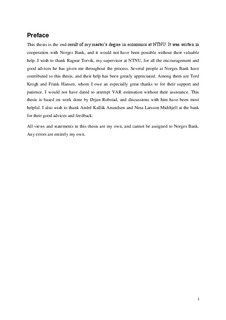| dc.description.abstract | There is an ongoing debate among economists and policy makers on whether the monetary policies followed by central banks in developed economies should be expanded to also include financial stability concerns. One way to include financial stability concerns in today’s inflation targeting regime is through the policy known as leaning. Leaning means that in times of high financial instability, the central bank will temporarily increase the policy rate with more than what is justified by the traditional inflation and output stability concerns. The idea behind leaning is that this policy rate increase will affect some underlying financial variables, e.g. credit growth or house price growth, in a way that reduce the probability of a financial crisis in the future. This would be the benefit of leaning. However, leaning is not without costs; temporarily increasing the policy rate means increased unemployment in the following quarters. Whether central banks are justified in pursuing leaning depends on which is greater - the costs or the benefits? In this thesis, I have calibrated Svensson’s (2015) cost-benefit analysis of leaning for Norway, as well as examined some of the assumptions made in the original analysis. Svensson evaluates how a temporary 1-percentage point increase in the policy rate affects the benefit and cost of leaning in Sweden for the following 10 years. He uses a DSGE model in order to estimate the effect of the monetary policy shock, and he utilizes credit growth as the financial variable that enables the policy rate to affect the crisis probability. Svensson finds that leaning in Sweden has only costs, and no benefits, meaning that leaning is not justified. In my analysis for Norway, I find that although the benefit are generally outweighed by the cost, leaning do in fact have a long-term benefit. I further argue that this difference between the effects found of leaning in Sweden and Norway is not caused by differences between the two countries, but instead caused by Svensson’s use of DSGE estimation, as opposed to my VAR estimation. A common assumption made in cost-benefit analyses of leaning, and which is also made by Svensson, is that a crisis will incur a fixed increase in unemployment by 5 percentage points. However, the literature on financial crises has found that the crisis cost is increasing in the level of credit growth before the crisis erupted. This means that if leaning is successful in reducing credit growth, not only will it reduce the crisis probability, but it will also reduce the crisis cost. Although expanding the analysis to include this additional effect greatly increases the benefits of leaning, it is still found that the cost of leaning outweigh the benefit. | nb_NO |
